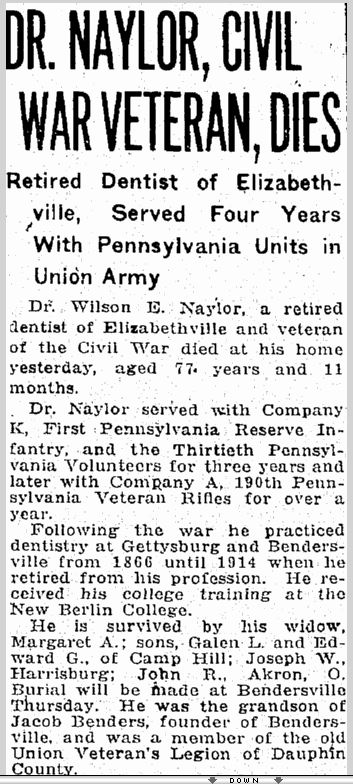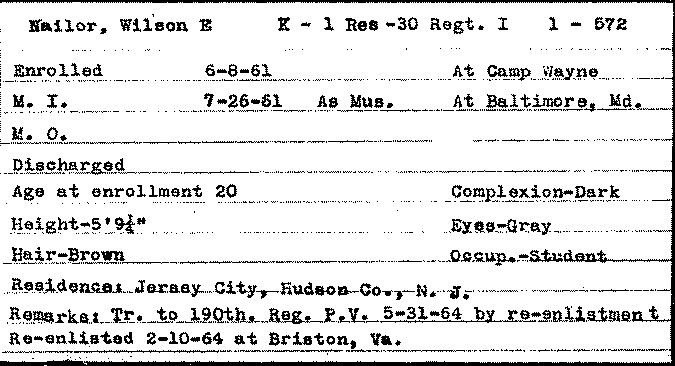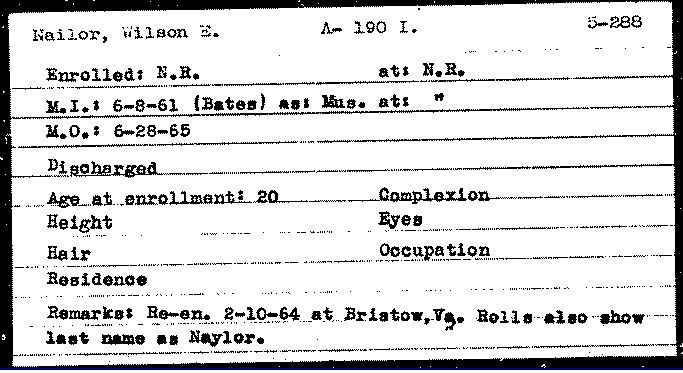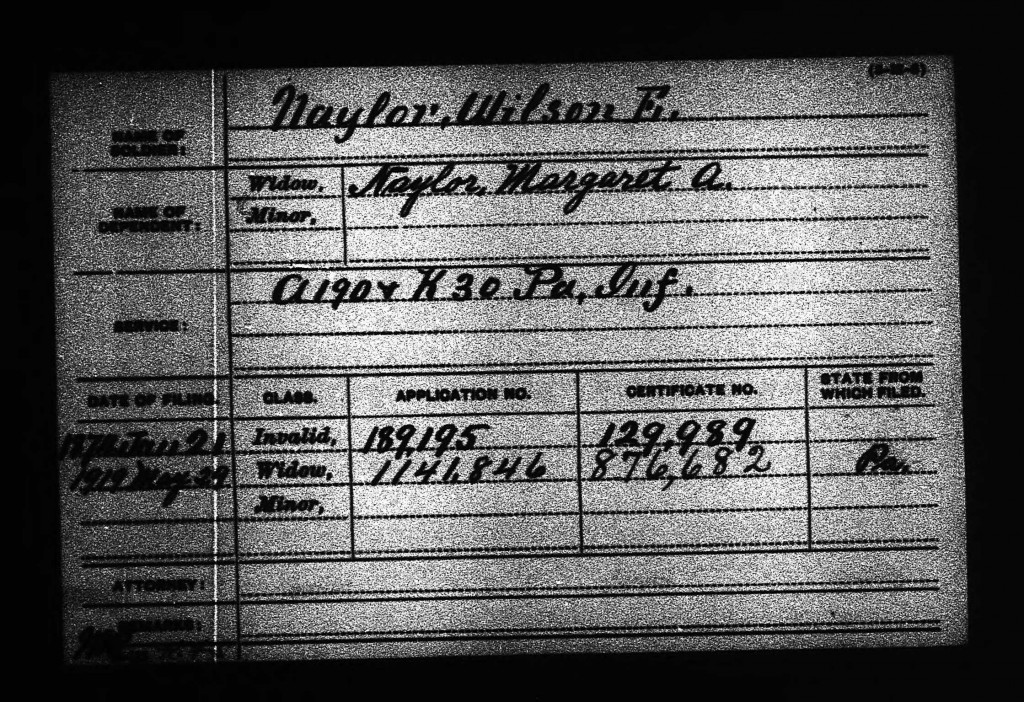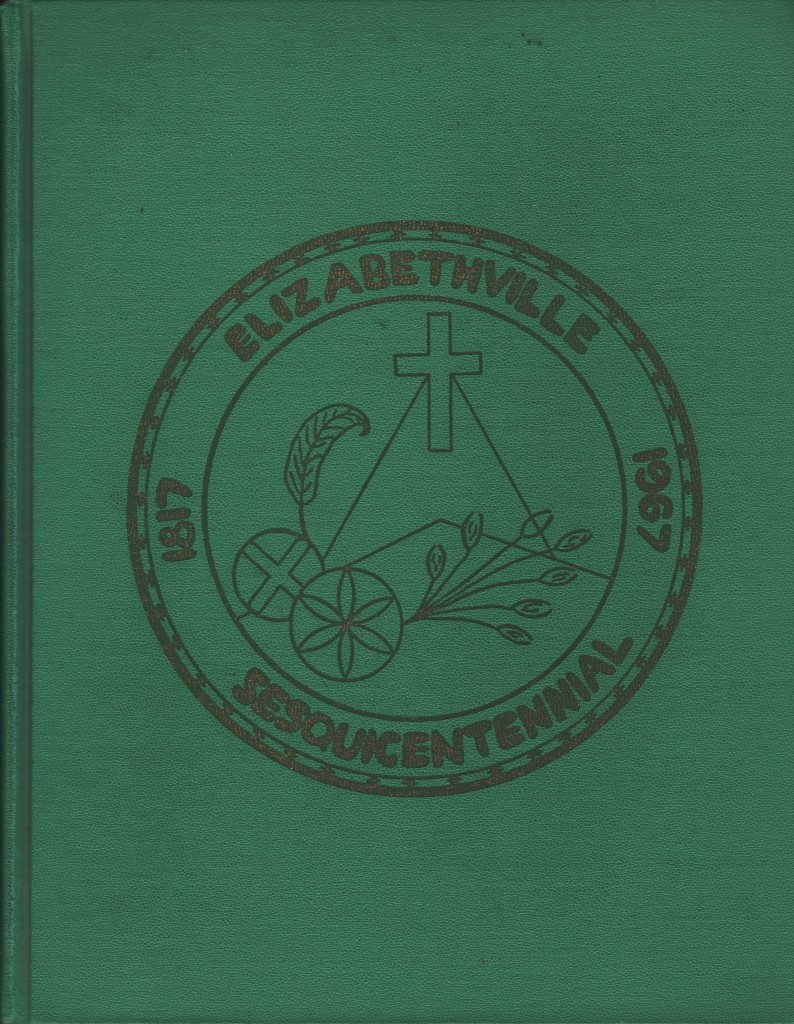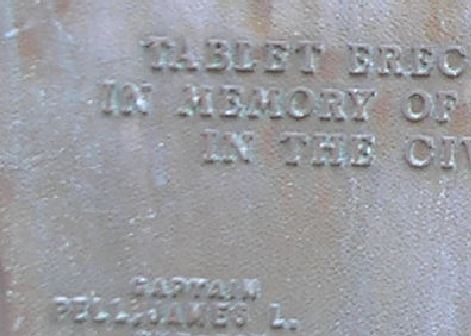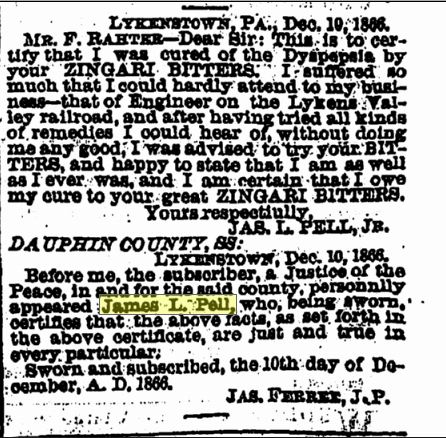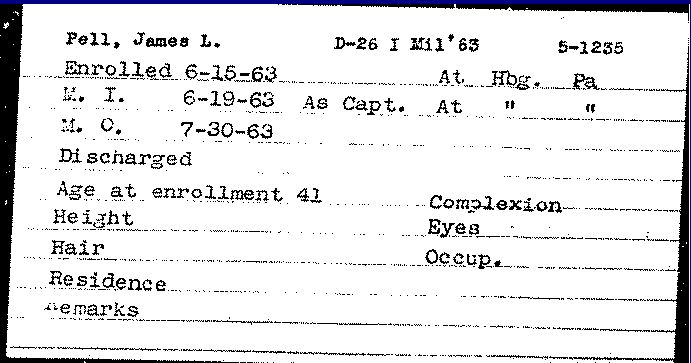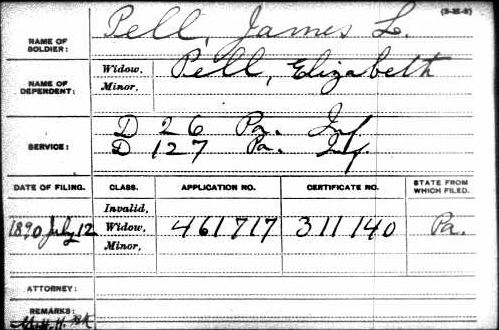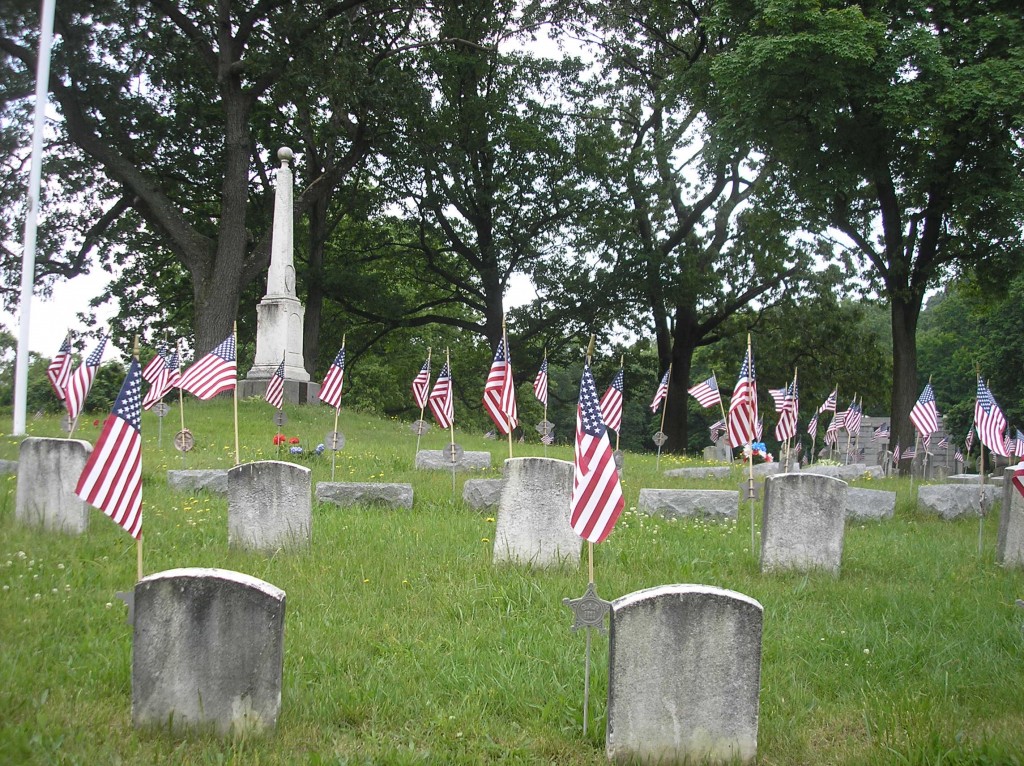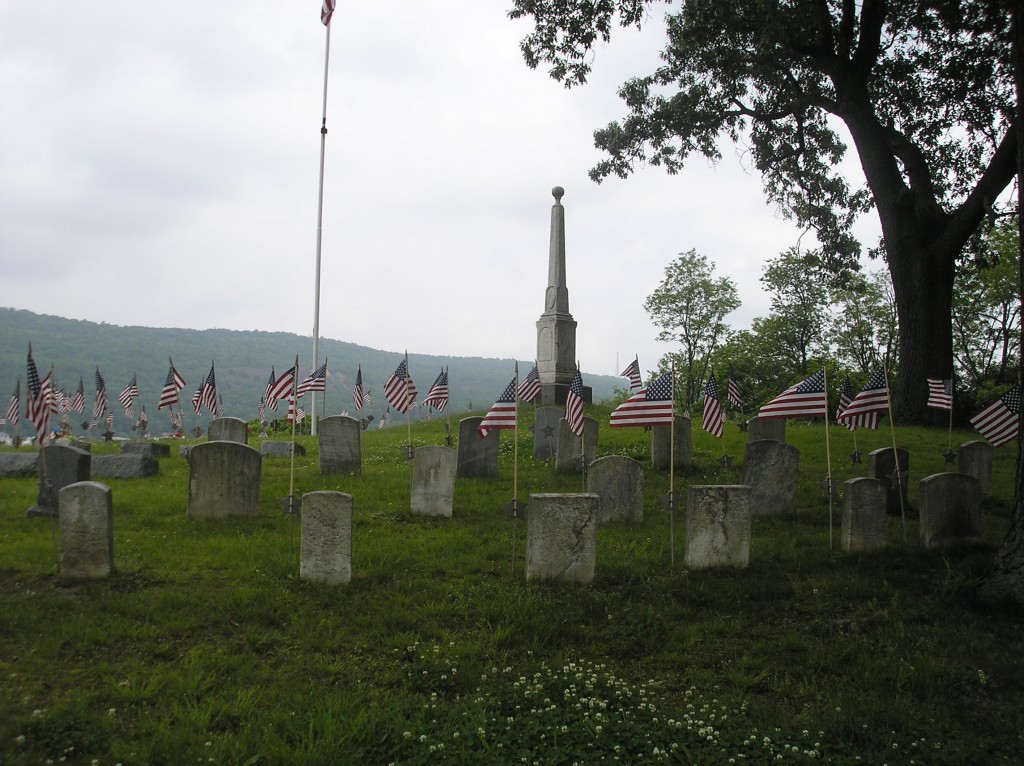Dr. Wilson E. Naylor – Elizabethville Dentist
Posted By Norman Gasbarro on November 3, 2012
DR. NAYLOR, CIVIL WAR VETERAN, DIES
Retired Dentist of Elizabethville, Served Four Years With Pennsylvania Units in Union Army
Dr. Wilson E. Naylor, a retired dentist of Elizabethville and veteran of the Civil War died at his home yesterday, aged 77 years and 11 months.
Dr. Naylor served with Company K, 1st Pennsylvania Reserve Infantry and the 30th Pennsylvania Volunteers [30th Pennsylvania Infantry] for three years and later with Company A, 190th Pennsylvania Veteran Rifles [190th Pennsylvania Infantry] for over a year.
Following the war he practiced dentistry at Gettysburg and Bendersville from 1866 until 1914 when he retired from his profession. He received his college training at the New Berlin College.
He is survived by his widow, Margaret A. Naylor; sons, Galen L. Naylor and Edward G. Naylor of Camp Hill; Joseph W. Naylor, Harrisburg; and John R. Naylor, Akron, Ohio. Burial will be made at Bendersville Thursday. He was the grandson of Jacob Benders, founded of Bendersville and was member of the old Union Veteran’s Legion of Dauphin County.
The above obituary appeared in the Harrisburg Patriot on 6 May 1919. Similar obituaries appeared in the Gettysburg Times of 7 May 1919, with the headline, “Dr. Naylor is Dead, Veteran of Civil War Lived in Adams County Fifty Years,” and adding that the funeral would be “at 1:30 o’clock, Rev. W. D. E. Scott officiating;” in the Gettysburg Compiler of 10 May 1919, with the headline, “Dr. Naylor, Formerly of Gettysburg, Dies at Elizabethville, Civil War Veteran;” and in other Pennsylvania newspaper such as the New Oxford Item, 15 May 1919.
The Union Veteran Legion, an organization of soldiers who served in the Civil War, to which Dr. Naylor belonged, was founded in 1884 and had much stricter requirements for service than did the G.A.R. The badge of the U.V.L, shown below, is from the U.S. Militaria Forum, a web site devoted to collectors preserving military memorabilia.

Dr. Naylor met the strict membership requirements by having enlisted prior to Gettysburg for a period of three years duration. The web site references a book by George G. Kane, The Union Veteran Legion, 1884-1939, as a good source for information on this group. A search of old Pennsylvania newspapers (on line) produced only 77 hits for “Union Veterans Legion,” with only one for the geographical area covered by the Civil War Research Project – a brief notice of the installation of a command at Tremont, reported in the Philadelphia Inquirer on 22 May 1892. Several of the hits, for Harrisburg Patriot articles, were for the encampment at Steelton, Dauphin County.
In the post of yesterday, Elizabethville Civil War Veterans List, it was mentioned that Dr. Wilson E. Naylor had not been previously included in the Veterans List for this Civil War Research Project and that research would be done to determine if he belongs. That research, now partially completed, began with discovery of the obituary of Dr. Naylor which appears at the top of this post. Clearly, his association with Elizabethville, makes him a prime candidate for inclusion!
Wilson E. Naylor enrolled in the 30th Pennsylvania Infantry (designated the 1st Pennsylvania Reserves) on 8 June 1861 at Camp Wayne (probably Chester County, Pennsylvania). At the time of his enrollment, he stood nearly 5′ 10″ tall, said he was 20 years old, had brown hair, grey eyes, and a dark complextion. He was a student in Jersey City, Hudson County, New Jersey. According to census and other information, he had been born in Bendersville, Adams County, and was the grandson (through his mother, Catherine [Bender] Naylor) of the founder of that town. The term of service of his enlistment was three years and he reported for duty at Baltimore, Maryland. His rank was that of Musician. In some military records, he is found as “Wilson E. Nailor” or “Wilson E. Nailer.”
At Gettysburg, while serving with the 30th Pennsylvania Infantry, he was wounded in the left shoulder.
His wound healed and he returned to the regiment, and on 10 February 1864, he re-enlisted at Bristoe, Virgina. The re-enlisted men of the 1st Pennsylvania Reserves transferred to the 190th Pennsylvania Infantry and Wilson E. Naylor joined Company A, continuing to serve as a Musician. His discharge was received from the 190th Pennsylvania Infantry on 28 June 1865.
After the war, Dr. Naylor married Mary J. Wert and with her had four children: Galen Lutz Naylor, who was born about 1869; George Naylor, born about 1871; Joseph W. Naylor, born about 1874; Edward G. Naylor, born about 1877; and John Reynolds Naylor. Two other children, Stella Naylor and Wert Naylor, died in infancy. After the death of Mary [Wert] Naylor in about 1889, Dr. Naylor re-married to Margaret Asper, some sources giving this second marriage date as 1881 while others give 1885. After spending about 50 years in the Bendersville area in the practice of dentistry, Dr. Naylor moved to Elizabethville, where he died on 5 May 1919.
In the 1910 Census for Elizabethville, Dr. Naylor declared that his occupation was dentist – which means that he was probably practicing dentistry in Elizabethville in the later years of his life. Interestingly, his second wife Margaret [Asper] Naylor was recorded in the census with an occupation. She was a “merchant – store keeper.” This was unusual for a woman at this early part of the 20th century. As of this writing, the nature of her business enterprise is not known. It is also not known why Dr. Naylor chose to move to Elizabethville. Perhaps it had something to do with either his family background or his second wife’s background.
Dr. Naylor’s mother’s maiden name was “Bender” and the original name of Elizabethville was Benderstettle. The original owner of the land on which the west end of Elizabethville is situated was Adam Bender, an immigrant from Bohemia, Germany. He left the land to his son, John Bender, who when he laid out the town building lots and sold them in 1817, changed the name to Elizabethville, in honor of his wife Elizabeth [Gipple] Bender. If there is a genealogical connection with the Jacob Bender, said to be the maternal grandfather of Wilson E. Naylor, it is not made clear by the biographies in the Elizabethville Sesquicentennial History.
For his service at Gettysburg, Dr. Naylor’s name appears on the Pennsylvania Memorial (above).
Dr. Naylor applied for an received a pension for his Civil War service. At his death, his second wife Margaret, who survived him, collected the widow’s pension. Wilson E. Naylor is buried in the Bendersville Cemetery, Adams County, Pennsylvania. His grave marker is pictured on Findagrave.
A biographical sketch of Dr. Naylor appears in the Commemorative Biographical Encyclopedia of Dauphin County Pennsylvania, page 1124.
—————————————-
Dr. Wilson E. Naylor will be added to the Veterans List of this project at the next update, which will occur in April 2013.
Anyone with further information on Dr. Naylor – his family, his practice of dentistry, or his Civil War service – is urged to contribute it. Especially needed are pictures and stories! Add comments to this post or click here to e-mail.
Pension Index Cards are from Ancestry.com. The news clipping at the top of this post is from the on-line resources of the Free Library of Philadelphia. References to other newspapers were obtained from the newspaper resources available on Ancestry.com. Pennsylvania Veterans’ Index Cards are from the Pennsylvania Archives. To search the York County Heritage Trust Database of Civil War Soldiers which was created by Dennis W. Brandt, click here.
 ;
;
